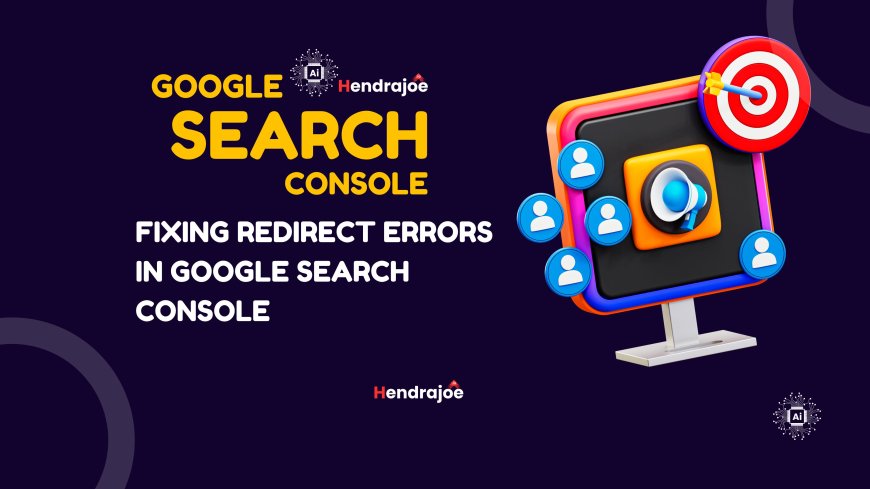Fixing Redirect Errors in Google Search Console
Learn how to fix redirect errors in Google Search Console. Discover the causes of redirect issues, common types of redirects, and step-by-step solutions to ensure your website’s URLs are properly redirected for optimal SEO

When you use Google Search Console (GSC) to monitor your website’s SEO health, you might come across redirect errors in the Coverage Report. These errors can cause significant problems for your site’s indexing and search performance. Redirect errors occur when there are issues with how URLs are being redirected, either due to incorrect configurations or technical problems that prevent Google from properly following the redirects.
In this guide, we’ll walk you through the different types of redirect errors, the common causes behind them, and how you can fix them to ensure that your website’s URLs are properly redirected, helping your site maintain optimal performance in search engine rankings.
What are Redirect Errors in Google Search Console?
Redirect errors in Google Search Console typically appear when Googlebot encounters issues with how a page on your site is being redirected to another URL. These errors are often seen in the Coverage Report, which monitors the status of your website’s pages in Google’s index.
A redirect occurs when a page is automatically sent to a different URL. There are different types of redirects, including 301 redirects (permanent) and 302 redirects (temporary). While redirects are generally beneficial for SEO, incorrect or poorly configured redirects can result in errors, making it harder for Google to index your pages.
When redirect errors are flagged in Google Search Console, it means that there’s an issue preventing Googlebot from following the intended redirect path, which can lead to poor indexing and crawlability issues.
Common Types of Redirect Errors
Before diving into solutions, let’s go over the most common types of redirect errors that you might encounter in Google Search Console:
1. Redirect Chains
A redirect chain occurs when there are multiple redirects between a user and the final destination. For example:
- Page A → Page B → Page C → Final URL
While redirect chains might work for users, Googlebot can struggle to follow chains that are too long, which could result in crawlability issues or delays in indexing.
2. Redirect Loops
A redirect loop happens when a page is redirected to another page, and that second page is then redirected back to the original one, causing an endless loop. For example:
- Page A → Page B → Page A
Redirect loops create an infinite cycle, preventing Googlebot from accessing the page and resulting in a crawl error.
3. 404 Errors After Redirect
Sometimes, a page might be redirected to a URL that leads to a 404 Not Found error page. This often happens when a redirect points to a non-existent page, or the destination URL has been incorrectly entered. When Googlebot follows a redirect to a broken link, it will flag it as an error.
4. Incorrect or Inconsistent Redirect Type
Using the wrong type of redirect can also cause errors. For instance, if you mistakenly use a 302 redirect (temporary redirect) when you intend for the redirect to be permanent, Google may not transfer the page’s SEO value and rankings to the new URL.
5. Redirecting to Non-Canonical Pages
Another issue is when you redirect a page to a non-canonical URL, which is not the preferred version of the page. This can confuse Google and result in duplicate content issues, affecting the page's SEO.
How to Fix Redirect Errors in Google Search Console
Now that we understand the common types of redirect errors, let's take a look at the solutions for fixing them. Follow these steps to troubleshoot and resolve redirect errors in Google Search Console:
1. Check the Redirect Path with the URL Inspection Tool
Google Search Console’s URL Inspection Tool is a valuable tool for checking how Googlebot views the redirects on your website. Follow these steps:
- Open Google Search Console and go to the URL Inspection Tool.
- Enter the URL that is flagged with a redirect error.
- Click on Test Live URL to see how Googlebot handles the URL and where it is being redirected.
This will give you a clear picture of the entire redirect chain and whether the final destination URL is being indexed correctly.
2. Resolve Redirect Chains
If your site has redirect chains, Googlebot may not be able to follow the redirects efficiently. To fix this:
-
Minimize Redirects: Limit the number of redirects in a chain to avoid delays in the crawling process. Ideally, ensure that each page redirects to its final destination with a single redirect.
-
Implement Direct Redirects: Instead of redirecting Page A to Page B, then Page B to Page C, set up a direct 301 redirect from Page A to the final destination. This will reduce the number of hops Googlebot has to make.
-
Review Server-Side Redirects: Make sure that your server-side redirects (e.g., in the .htaccess file for Apache servers or using server-side rules for Nginx) are set up properly and efficiently.
3. Fix Redirect Loops
Redirect loops can prevent Googlebot from crawling pages and cause the URL to be ignored in the index. Here’s how to fix redirect loops:
-
Identify the Redirect Loop: Use the URL Inspection Tool to detect if a page is in a loop. If the URL is redirecting to itself or back to the original page, you will see an issue.
-
Resolve the Issue in Your Configuration: Check your server settings or CMS configuration for any conflicting redirect rules. For example, a common mistake is setting up a redirect from Page A to Page B and then another redirect from Page B back to Page A.
-
Avoid Infinite Redirects: Make sure your redirects are directed towards a final, stable destination, and that there’s no circular path in the redirects.
4. Fix 404 Errors After Redirect
If a page is redirecting to a 404 Not Found page, the redirect is broken and needs to be corrected. Here’s how to fix it:
-
Check the Destination URL: If the redirect is pointing to a URL that doesn’t exist, make sure the destination page is active and live.
-
Update the Redirect: If the target page has been moved or deleted, update the redirect to point to the correct or updated URL. Ensure that the destination is an active page that returns a 200 OK status.
-
Use 301 Redirects for Permanently Moved Pages: If a page has permanently moved to a new URL, ensure that a 301 permanent redirect is set up to pass the SEO value to the new page.
5. Correct Redirect Type (301 vs 302)
Using the wrong type of redirect can lead to SEO problems. Here’s how to get it right:
-
Use 301 Redirects for Permanent Moves: If a page has permanently moved to a new URL, use a 301 redirect. This tells Googlebot that the page has permanently moved, and all SEO equity should be passed to the new URL.
-
Use 302 Redirects for Temporary Moves: If the page is only temporarily moved or unavailable, use a 302 redirect. This tells Googlebot not to pass the page’s SEO value to the new URL and that it should expect the page to return at some point.
-
Check Redirects Using Google Search Console: Use the URL Inspection Tool to verify that your redirect is set up correctly, and Google is following it as expected.
6. Avoid Redirecting to Non-Canonical Pages
If you’re redirecting to non-canonical URLs, Google might face issues with indexing and duplicate content. Here’s how to fix it:
-
Ensure Redirects Point to Canonical URLs: Always ensure that your redirects lead to the correct, canonical version of a page. This will help Googlebot understand which version of the page should be indexed.
-
Check Canonical Tags: Use rel=canonical tags to inform Google about the preferred version of a page. Avoid setting up redirects that lead to non-canonical URLs to prevent confusion and SEO issues.
Best Practices to Avoid Redirect Errors in the Future
To minimize the chances of redirect errors affecting your site, follow these best practices:
-
Keep Redirects Clean and Simple: Avoid unnecessary redirect chains and loops. A clean, single redirect to the final destination is always best for SEO.
-
Test Redirects Regularly: Use the URL Inspection Tool in Google Search Console to regularly check the health of your redirects. If you make changes to your redirects, re-test them to ensure they’re working correctly.
-
Monitor Your Site’s Crawlability: Regularly review your Coverage Report in Google Search Console to identify crawl issues related to redirects. Address these promptly to ensure Googlebot can crawl and index your pages efficiently.
-
Keep URLs Consistent: Avoid frequent changes to URLs unless necessary. Consistency helps prevent redirect errors and ensures that the correct pages are indexed.
Conclusion
Redirect errors in Google Search Console can have a negative impact on your site’s indexing and SEO performance, but they’re fixable with a little troubleshooting. By following the steps outlined in this guide, you can address issues with redirect chains, loops, 404 errors, incorrect redirect types, and more.
If you have any questions or need further help with redirect errors, feel free to leave a comment below. And don’t forget to visit my website regularly for more SEO tips and updates!
What's Your Reaction?









































